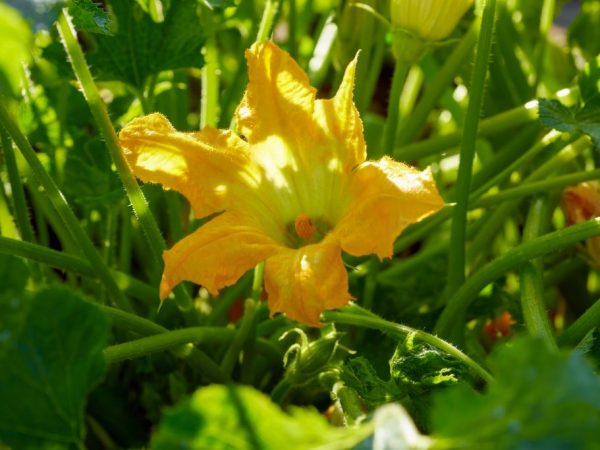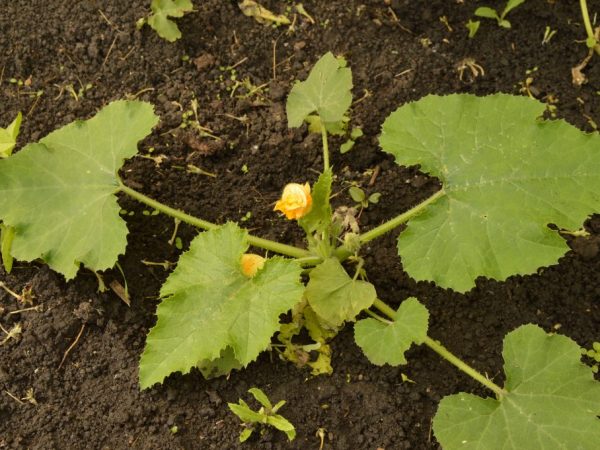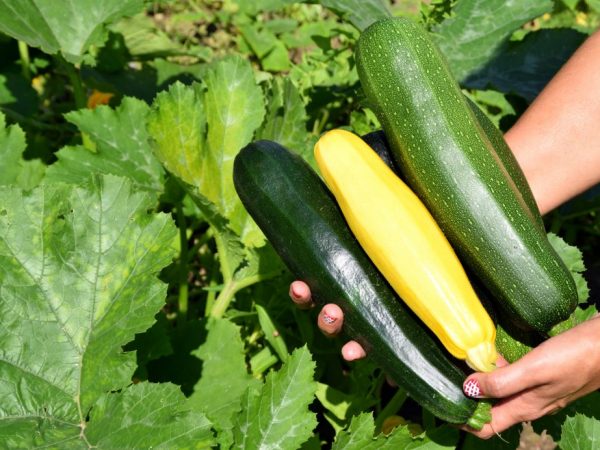Growing zucchini in a barrel
Growing zucchini in a barrel is an achievement of gardeners, which allows you to get a tasty and good harvest of vegetables with minimal labor and financial costs. Bush varieties and hybrids are suitable for growing zucchini.

Growing zucchini in a barrel
Seed preparation
The following varieties are most suitable for growing seedlings:
- Pharaoh;
- Sosnovsky;
- Apollo F1;
- White-fruited;
- Gribovsky 37;
- Long-fruited.
Before sowing, the seeds of bush varieties should be warmed up, then the seedlings will germinate at the same time, and the yield will be large. For this, the seeds are placed on a heating battery and kept there for a day.
After drying, the seeds are soaked in warm water (40-45 °). After they are swollen, they are removed and laid out in layers on a damp cloth. Do not use gauze, because in its loose structure, the sprouts can get tangled and break off.
At room temperature, the seeds will sprout of the desired length in 4-5 days, after which they are planted. Do not pull until the sprouts are too long, such seedlings are difficult to plant without breaking off the sprouts.
Germination of seedlings
To obtain seedlings, use the halves of the eggshell. Empty and dried halves are filled with peat soil and seeds are placed in their center - 1 piece in each. Then the seedlings are irrigated from a spray bottle and placed in a warm place with diffused lighting. In such an environment, the sprouts will not only grow up quickly, but will also receive additional nutrition from the shell.
As soon as the seedlings get stronger and release a pair of leaves, they are planted in small flowerpots or pots with a diameter of 10-12 cm, without removing them from the shell.
Barrel preparation
Growing zucchini is required in a container with a volume of at least 200 liters. A container made of iron, plastic or wood is also used. A barrel that is too narrow and deep is best cut in half, a wide and shallow barrel should be left intact. In the absence of such a container, a roomy old pan or bucket is used.
In the middle of the container, it is required to insert a tube punched in several places. It will be used to further moisturize the plantings. Several holes are made at the bottom of the barrel, which will serve to drain excess liquid when watering.
Before filling the barrel with soil, you should decide on its location, because it will be problematic to move the filled container. To get an early harvest, marrow in a barrel is placed in a place where there are no drafts and a lot of sun. In such conditions, the soil warms up faster and the sprouts will begin to actively develop.
Some gardeners place the barrel next to the flower garden, creating a beautiful arrangement.
Soil preparation

The soil should be low in acidity
The vegetation remaining in the garden is used as drainage - shoots of fruit trees and shrubs crushed into segments. A layer of garden waste is placed on top of the drainage. Vegetable tops, dry leaves are suitable. Then peat, humus or mole soil is laid.The soil mixture is slightly compacted, leaving 15 cm of empty space so that the plants do not break during growth.
Supports for bushes are installed if necessary. If the variety is undersized, then soil is poured into the barrel as the bush grows. Zucchini is grown in barrels using low-acid soil. For deoxidation, ground chalk or dolomite flour is added to the soil.
Planting seedlings in a barrel
Before planting the zucchini in a barrel, the soil is watered abundantly, then loosened and leveled. The plant is transplanted after the appearance of the third leaf around the second decade of May. By this time, the threat of the last frost has passed, and the soil will warm up to the required temperature.
It will be possible to plant 1-3 sprouts in one container. Tall varieties are planted one at a time, small ones - 2-3 pcs. in one barrel.
After planting, the plants are watered, slightly huddled, and covered overnight with light material - burlap or agrofibre. At this time of day, the air is still cool and can negatively affect the growth and development of the bushes.
3-4 days after planting, the zucchini in a barrel should be fed to stimulate the growth of green mass. Fertilize the planting with a solution of nitroammofoska (20 g of the substance is dissolved in 10 l of water). For good nutrition, you will need about a bucket of working staff. To eliminate the risk of burning the roots and increase the absorption of nutrients, fertilizing is combined with watering.
Care
After the zucchini are planted, a number of important activities are carried out:
- Water regularly as the surface layer of the soil dries out (up to 20 liters of water are consumed per 1 m² of plot). For irrigation, warm, settled water is used; from cold water, squash bushes can get sick, rot and die. The soil is moistened through a tube in the middle of the barrel.
- Loosen the soil frequently to maintain its moisture and air permeability, as well as to accelerate the development of the root system.
- To accelerate the processes of natural pollination and increase the number of ovaries, foliage is sprayed with a sweet solution (honey and water), which attracts pollinating insects.
- At the very beginning of the flowering of the ovary, an artificial pollination procedure is required. This manipulation is carried out using a pollen flower without petals.
Advantages and disadvantages
It will be possible to evaluate all the advantages of this growing method only after the plants grow up, form dense foliage and the first ovaries. Benefits of growing zucchini in barrels:
- getting an early harvest;
- high quality and quantitative indicators of productivity;
- ease of care;
- the risk of viral, fungal and bacterial infections is significantly reduced, since the plants practically do not come into contact with the ground;
- low consumption of land and water during irrigation;
- aesthetics and decorativeness of plantings.
Harvesting rules

Several layers of the crop are removed per season
For cutting vegetables, it is better to use a well-sharpened knife, which will allow you to easily remove vegetables without damage. Fruits develop on a thick and juicy stalk. If it has already turned yellow or dried out, such specimens are not suitable for consumption, because are overripe.
For the whole season, several harvests are carried out at different ripening periods. It all depends on the further use of vegetables. Young, not overripe vegetables are suitable for freezing, drying and canning. They are used for cooking stews, stewing, baking.
For winter consumption, wait until the vegetables are fully ripe. They are kept on the bush for about 120 days so that the skin becomes firmer and smoother. In a cool place, such fruits can lie until spring without losing their taste and marketability.
It will be possible to determine the ripeness of the fruit by sound. If it is deaf and the skin is difficult to remove, then it's time to remove the vegetables. Leave 2-3 cm of fruit during the cut.In a few days, this part will dry out, which eliminates the risk of developing infections.
To avoid rotting unripe zucchini in a barrel in damp weather, any dense material is placed under each instance, for example, cardboard or tree bark. This prevents the development of diseases.
Gardening tips
To grow strong bushes with abundant flowering and numerous ovaries, you should follow simple rules:
- At the beginning of the growing season and before flowering, it is required to carry out the pinching of the growth point (chasing). This will form a large number of ovaries and produce more fruit.
- After the bushes have faded, all inflorescences on which ovaries have not formed should be removed, because they take away a lot of strength, energy and nutrients from the plant, which negatively affects the harvest.
- In the last decade of August, when the fruits are formed and take on the desired color, foliage should be cut out, which covers the ripening fruits from the sun.
- The lining under the vegetables of cardboard or wood will be an excellent protection of vegetables from slugs and snails that love to feast on their pulp.
- Harvesting should be done on time, because overripe vegetables have poor keeping quality and taste.
- The culture does not like overfeeding and from an excess of nutrients will increase the green mass without forming ovaries. An excess of nutrients can lead to the development of diseases, decay of bushes and their death.
- It is also required to follow the rules of crop rotation. Onions, radishes, cabbage, potatoes, legumes, tomatoes, carrots and greens should be grown in front of zucchini on this land.
Conclusion
It is not difficult to grow zucchini in a barrel, the main thing is to choose the right container, the correct soil composition, prepare the seeds and grow high-quality seedlings from them. In the future, only care and regular collection of zucchini are required from the summer resident.

